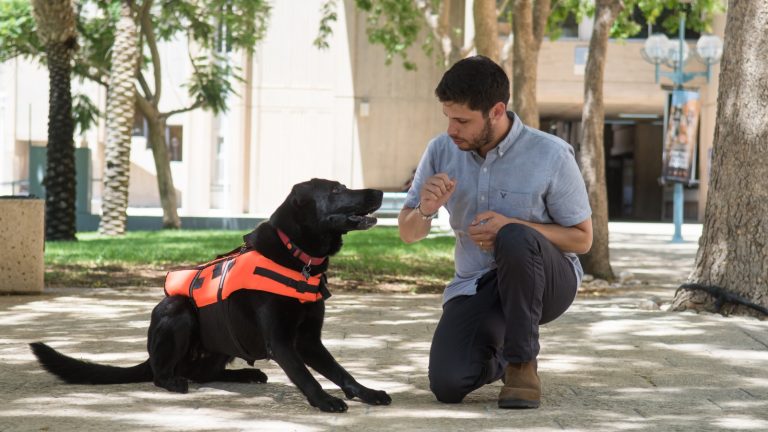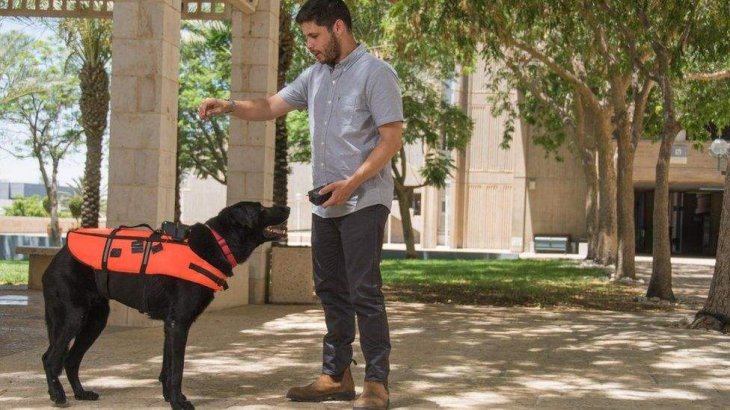This Haptic Vest Helps Us Control Dogs Remotely And Quickly
Viswamitra Jayavant - Jul 27, 2019

Dogs are men's best friends, but we have always had troubles with communicating with them. Researchers from Israel have created a haptic vest that can make dogs more responsive to commands than ever.
- This Robotic Gripper Wraps Around Objects Like An Elephant Trunk
- Toyota Is Building A High Tech City Where AI, Robots, And Humans Live Alongside Each Other
- Bengaluru Students Are Enjoying Robotics Classes At Schools, Other Schools In Inda Shoud Follow
Instincts can be powerful cues. For example, when your phone vibrates in your pocket with a notification, your first instinct is to drop whatever you’re doing and take it up. That’s essentially what researchers from Israel are trying to do with dogs: By harnessing them with a vibrating vest, the handlers or owners can remotely control their dogs through silent commands translated into specific vibrations within a haptic vest.

Dogs At the Front Line
Dogs aren’t just humans’ best friends. They’re also confidential partners in a line of some very important (and dangerous) jobs. From search and rescue mission where their amazing sense of smell can track down a person for miles, to bomb and drug-detecting for police and the military. K-9 units have also been greatly useful for law enforcement to track down and apprehend suspects.
Dogs are obedient and to a degree, smart. They can be trained to respond to a series of commands such as whistles, key phrases, and with advanced training, even hand signals. But, just like us, dogs can only do these tasks when they see or hear the commands. And in the chaotic working environment that dogs often find themselves in the middle of, this can be quite a luxury.
Haptic Vest
Before the arrival of this vest, handlers will have to rely on a large megaphone or an obscenely loud whistles to get the dog’s attention or keep in contact with it after it had ventured into dangerous territories. Researchers from Ben-Gurion University’s Robotics Lab in Israel have placed a vibrating motor within an ordinary, lightweight mesh canine vest. The motor touches the sides and the back of the dog to provide certain levels of haptic feedback.
The Lab’s test subject was a mixed breed between a Labrador Retriever and German Shepherd named Tai. The rate that he learned different commands through the patterns, locations, and duration of each vibration was amazing. In no time, he learned commands such as ‘spin’, ‘down’, and even advanced commands like ‘back pedal’.
Of course, since the motor can be wirelessly controlled through a remote, the handler doesn’t need to be in listening or visual range of the dog at all. The researchers also found that Tai actually found it easier and quicker to respond to haptic commands instead of vocal or visual. On average, he learned each haptic command at a rate of one command every hour.
Let’s say in a search and rescue operation in terrains or environments too dangerous for a human to safely traverse. A camera can be mounted on top of the dog’s vest and the handler can just sit from afar, directing the dog’s motions through the vest.

Great Uses Elsewhere
But the benefits of this finding will not only be enjoyed by the military, law enforcement, and civil serving roles. It could also be used to improve the life quality of animals that are blind, deaf, or have degraded sensory. Pet owners who have physical challenges can also find great use in such a vest. Furthermore, it adds another method of communicating between humans and dogs, and this method is no doubt considerably more humane than shock collars and the likes.
Featured Stories

Features - Jul 01, 2025
What Are The Fastest Passenger Vehicles Ever Created?

Features - Jun 25, 2025
Japan Hydrogen Breakthrough: Scientists Crack the Clean Energy Code with...

ICT News - Jun 25, 2025
AI Intimidation Tactics: CEOs Turn Flawed Technology Into Employee Fear Machine

Review - Jun 25, 2025
Windows 11 Problems: Is Microsoft's "Best" OS Actually Getting Worse?

Features - Jun 22, 2025
Telegram Founder Pavel Durov Plans to Split $14 Billion Fortune Among 106 Children

ICT News - Jun 22, 2025
Neuralink Telepathy Chip Enables Quadriplegic Rob Greiner to Control Games with...

Features - Jun 21, 2025
This Over $100 Bottle Has Nothing But Fresh Air Inside

Features - Jun 18, 2025
Best Mobile VPN Apps for Gaming 2025: Complete Guide

Features - Jun 18, 2025
A Math Formula Tells Us How Long Everything Will Live

Features - Jun 16, 2025
Comments
Sort by Newest | Popular